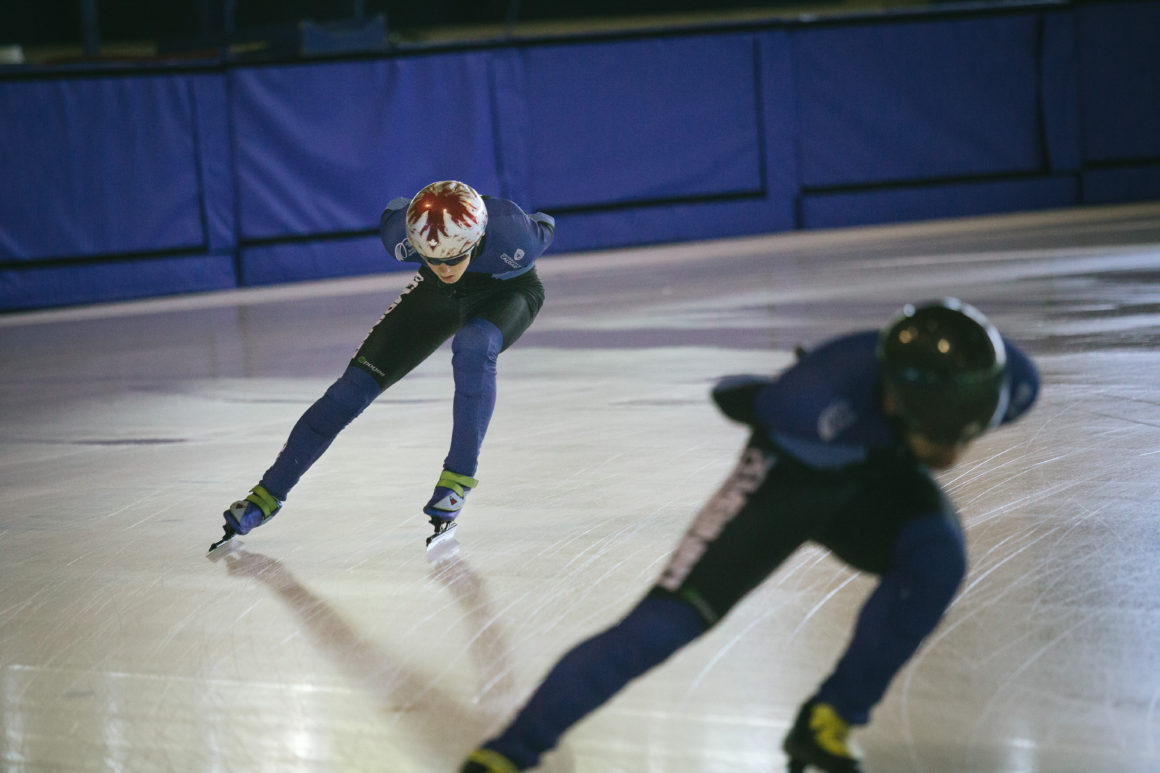
How to compete like a short track speed skater
By Anneke Pederson, September 6 2016 —
Competition season is the time when an athlete’s training is put to the test. Strategies are honed as each athlete battles their way to the top over the course of seven months.
This year at the Olympic Oval, the top speed skaters in Canada will be competing at their best, jockeying for positions on the Canadian national team to secure their ticket to compete internationally. This year, I’ll be one of them.
Competitions are a stressful time for high-performance athletes. Competitive speed skaters race almost every weekend and being at your best is necessary when at every opportunity a position on a team or a chance for a medal is on the line. But I try not to focus too much on the details. What I love most about competition is the excitement of the race itself.
The roar of the crowd, the clanging of the final lap bell. The skaters — anywhere from about four to eight people — line up a foot behind the line. The starter waves everyone forward.
“Go to the start.” The electronic gun is raised. The skaters wait at the line.
“Ready.” Each athlete crouches, their back legs prepared to launch them forwards like hockey players on a breakaway.
Then, with a loud bang and a flash of light, they’re off. Upon entering the corner, the skaters move their feet quickly, moving into the basic position they’re known for. While every race is fast at some point, some races start faster than others. If it’s 500m, it’s an all-out sprint. If it’s a 1000, 1500 or 3000m race, it may start a little slower while everyone jockeys for a good position, akin to to the physicality of roller derby. The skaters’ quick steps change to long, rhythmic ones as they pick up speed, applying more pressure to the ice. They’re fighting force, racing the clock and trying to outsmart their opponents.
Placement is more important in short track despite each race being timed. Even the most well planned race can go awry. No one knows who will win. Perhaps the leader will tire, or even slip and fall. Maybe they’ll take another skater down with them. Maybe there are hidden alliances. Maybe two skaters in the back of the pack will rush forward to take the lead, crushing their opponents with beautifully synchronized passes and blocks.
Passing is not as simple as you might think. Aside from what we call “suicide passes” — a desperate, last-minute attempt to get ahead — most passes are set up a lap in advance. Passes can also get you disqualified if executed improperly. For example, when passing a skater just before the beginning of the corner, you need to be ahead of them by the black markers, otherwise the other skater technically has the right of way and you are impeding the first skater’s track.
Signalling the final lap, a bell clangs and the spectators go wild. Coming up to the finish, every athlete looks close. In a final attempt to claim first, the first two skaters shoot their blades forward to touch the line.
With so many skaters so close in ability, speed and strength, “shooting the line” is a common way to finish a race. Even when alone, some skaters will do this to get the best time they can, which may help give them a higher seeding later in the competition. Short track speed skating is a complex sport that requires solid technical knowledge, endurance, explosive muscle and strategy. In a race situation, every millisecond can count against you.
You can catch all the action for yourself this season. The Olympic Oval on campus will host the International Skating Union (ISU) World Cup Short Track Speed Skating competition from November 4–6, and later on in the year the ISU World Sprint Speed Skating Championships from February 25–26. Skaters from around the world will battle it out for World Cup medals at these exciting events. Tickets are available in advance on the ISU’s website.
But for students, that’s not all that’s happening at the oval. The Intercontinental Short Track Invitational is held October 7–9, as well as other competitions scattered across the year.
Admission to these events are often free to the public. You can check out the Oval’s website for more details or plan a visit to the Oval to see the fastest sport on ice for yourself.
